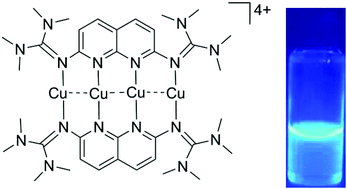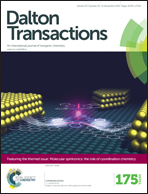Construction of copper chains with new fluorescent guanidino-functionalized naphthyridine ligands†
Abstract
The three new blue-fluorescent ligands 2,7-bis(tetramethylguanidino)-1,8-naphthyridine (1), 2,7-bis(N,N′-dimethylethylene-guanidino)-1,8-naphthyridine (2) and 2,7-bis(N,N′-diisopropylguanidino)-1,8-naphthyridine (3) are synthesized, and their optical properties (electronic absorption and emission spectroscopy) studied. Reactions of 1 or 2 with [Cu(CH3CN)4]BF4 yield the Cu4 chain compounds [Cu4(1)2](BF4)4 (that crystallizes as [Cu4(1)2(CH3CN)2](BF4)4·2CH2Cl2) and [Cu4(2)2](BF4)4. The variations of the optical properties upon coordination are evaluated, and the electronic transitions identified by time-dependent DFT (TD-DFT) calculations. Then the redox properties of the new Cu4 chain complexes are studied. In the course of these experiments, the new Cu6 complex [Cu4(1)2(CuCl2)2]2+, in which two CuCl2− units coordinate to the Cu4 chain in [Cu4(1)2]4+, was fully characterized. In addition, the Cu3 chain complexes [Cu3(1)3]3+ and [Cu3(1)2]3+ were isolated as products of redox-induced degradation processes. Finally, we show by quantum chemical calculations that in [M4(1)2]4+ complexes (M = coinage metal), the HOMO changes from a ligand-centered to a metal-centered orbital for replacement of M = Cu by Au.


 Please wait while we load your content...
Please wait while we load your content...